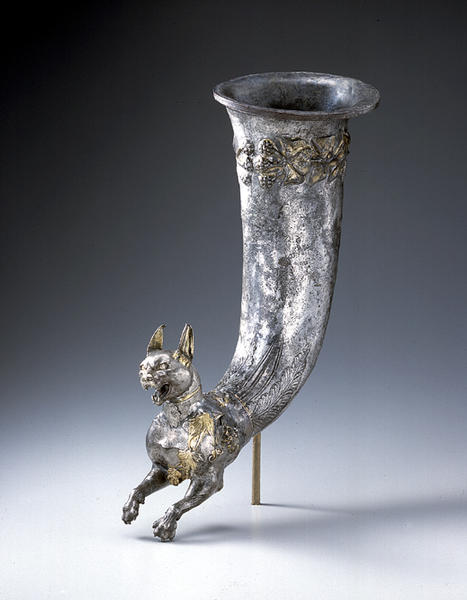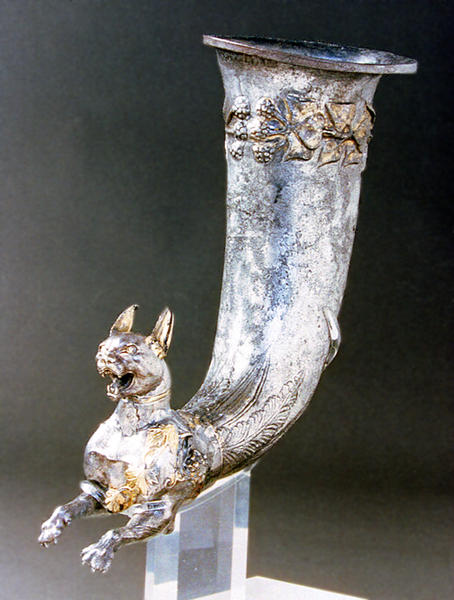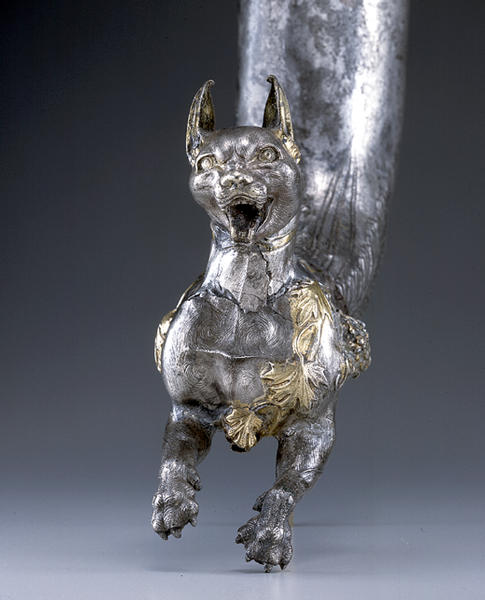山猫形リュトン
- パルティア
- 紀元前1世紀
- 銀鍍金
- H-44 D-15
解説(古代バクトリア遺宝展)
29山猫形リュトン
前1世紀
鍍金銀
長44.0 cm 口径15.0 cm
30鶏を銜える山猫形リュトン
前2世紀後期―前1世紀
鍍金銀
長41.4 cm 口径15.2-15.4 cm
作品30の銀製リュトンはその端に鶏を銜える大山猫の前半身をつけ、鶏の胸部を注口としている。鶏の全身を鍍金することによって山猫と明確に区別をし、山猫には目と耳の内側を鍍金して表情を与えている。この長い耳の尖った先端がやや内側に翻るような力のこもった大山猫の意匠は、紀元前後のヘレニズム世界の宝飾品にもいくつか類例が知られている。このリュトンの大山猫は鍍金をした首輪をしているが、これは当時狩猟用に飼いならされていたことを示すものであろう。大山猫はディオニュソスの獣、豹としばしば同一視されたが、この獣の前半身をつけた銀製リュトンは他にもいくつか類例が知られ、作品29に見られるように器や山猫の体躯に蔦、葡萄の意匠を施したものがあり、ディオニュソス祭祀と深い関係のあったことが分かる。そしてディオニュソスの秘儀にはこのような猫科の猛獣・・豹や大山猫の形をつけたリュトンが儀器として深くかかわっていたことが知られている。アメリカのポール・ゲッティー美術館やサックラー・ギャラリーの類例は、体躯の毛並み表現の他、肩に一種の渦巻く放射状の意匠を施してあるが、作品29、30の大山猫には渦巻く毛並み表現は見られるものの、この類の渦巻文は見られない。猛烈な勢いで鶏に襲いかかり貪る山猫と今にも息絶えそうな鶏といった迫真の表現は紛れもなくギリシャ由来の職人技であるが、猛獣とその獲物を組み合わせる意匠は西アジアのものである。
鶏を銜える山猫形リュトン
Catalogue Entry(Bac#029,030)
29
Lynx Rhyton
1st century B.C.
Gilded silver
L. 44.0 cm, Mouth dia. 15.0 cm
30
Rhyton with the Protome of a Desert
Lynx Catching a Fowl
Late 2nd‐1st century B.C.
Gilded silver
L. 41.4 cm, Mouth dia. 15.2-15.4 cm
The silver rhyton at no. 30 shows the forequarters of a desert lynx catching a fowl in its paws, while the chest of the bird forms the spout. The entire figure of the bird is gilded and contrasts clearly with the cat's form, while the cat's eyes and the insides of its ears are also gilded. The long ears are pointed at their tips and curve in slightly as part of the expression of this powerful cat. There are several examples of Hellenistic jewelry with similar cat motifs from around the time of Christ. This cat is wearing a gilded collar, and this probably indicates that such animals were kept for hunting purposes during this period. The desert lynx is a Dionysian beast, and it is frequently shown alongside leopards. There are also several similar examples of rhyta with attached animal forequarters, and as can be seen in cat. No. 29, the lynx's body is decorated with vine and grape motifs, clearly indicating a deep relationship with the rites of Dionysus. And we know that the mystery of Dionysus included ritual vessels featuring this kind of hunting cat, such as a leopard or lynx. Similar examples in the J. Paul Getty Museum and the Sackler Gallery have the same kind of hair depiction on the animals' body, and a spiral motif on their shoulders. The curling hair motif on the lynxes on cat. Nos. 29 and 30 are not the same kind of motif. The lynx violently plunging and capturing the bird in such amazingly life-like form that we can almost feel the bird's surprise. A Greek craftsman with unparalleled skill created this motif which, in fact, originated in west Asia.
鶏を銜える山猫形リュトン


